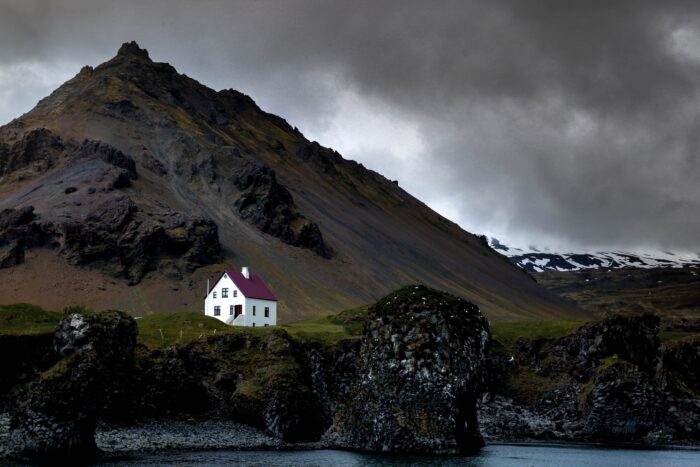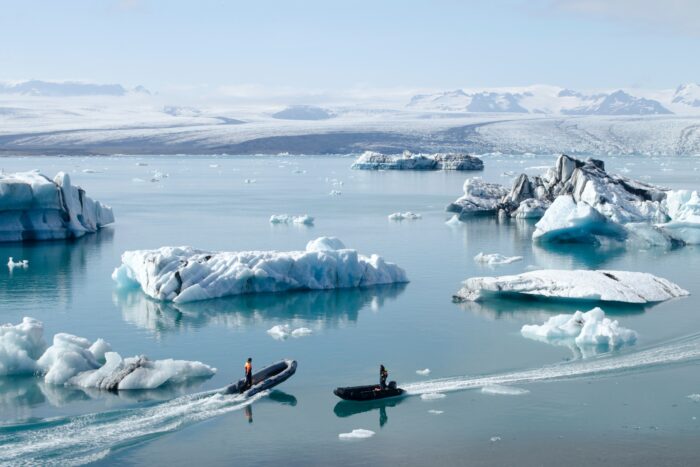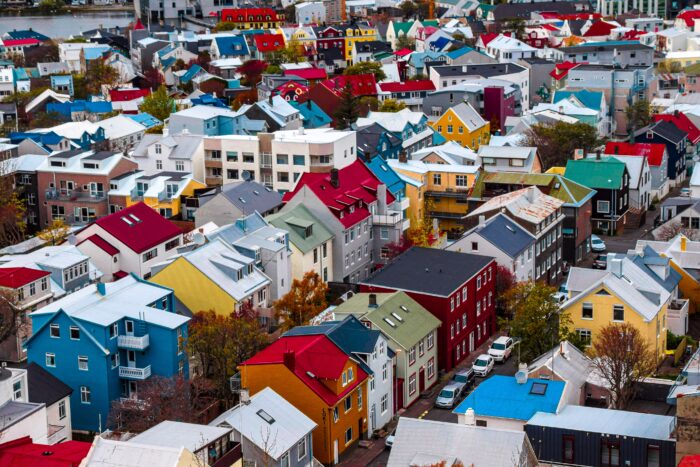A Complete Guide to Living in Iceland as an American
Iceland: the Land of Fire and Ice. It sounds like a fairytale for most Americans, but if you’re a remote worker you might be able to call it home for a bit. Imagine being able to see the aurora borealis, shake off the winter cold by soaking in your town’s hot spring, or hike among waterfalls next to lava formations, volcanoes and mountains.

Iceland’s beauty and fascinating culture has made it one of the most popular tourist destinations—that along with Game of Thrones and cheap flights in the 2010s. But we’re not just talking about spending a weekend there as a tourist, but actually living in Iceland.
In this article, we’ll talk about the pros and cons of living in Iceland, how to move to Iceland as a US citizen (i.e. visas), and what you can expect in terms of cost of living, culture, and environment.
Iceland immigration: Can US citizens live in Iceland?
The short answer is YES. However, if you’re wondering how easy it is to move to Iceland—the answer is HARD. Like most Nordic countries, immigrating to Iceland is one of the harder countries to relocate to for non-European citizen. Typically work, study, or marriage are the main ways to qualify for a long-term visa but given the country’s population of roughly 366,000 jobs, universities, and potential partners are pretty scarce.
While we want to show you your options we also want to be transparent that Iceland immigration policy is tough. To put the challenge of living in Iceland into perspective, there are only about 1,000 Americans in Iceland currently. However, a move to Iceland isn’t impossible. Here some info if you’re set on moving to Iceland to work or study—keep reading to find out the most viable option for Americans…Iceland’s digital nomad visa.
Working in Iceland
Since Iceland’s population is aging and nearing retirement, the country hires about 2,000 foreign workers every year to fill the employment gap. It’s a small window of opportunity, but an opportunity nonetheless if your skills are in high demand.
If you’re lucky enough to get an offer from an employer in Iceland (congrats!) they will need to fill out a document that explains why the position can’t be filled by a local, so any subspecialties, or advanced technical skills are a plus.
While Americans can often use their native English speaking skills as an advantage abroad, English is taught as a second language and most Icelanders speak English fluently.

Studying in Iceland
There are seven nationally-accredited universities that have programs open for foreign students. Since the country has no central admissions system, you’ll have to apply directly to your desired university. You can also apply for scholarships at the Reykjavik University, the University of Iceland, and the Iceland Ministry of Education, Science and Culture.
Both work and student visas are only valid during the duration of your contract or enrollment. You’ll have to re-apply for a new visa if you change jobs or graduate in order to continue living in Iceland.
Jobs in Iceland for foreigners
As stated, getting a job in Iceland is hard but your chances of getting a work permit and living in Iceland increases significantly if you are one of the following:
- Qualified professional
Iceland’s biggest growing sectors are construction, healthcare, tourism, and IT. If you’re highly-skilled in any of these fields, you may have an easier time finding employment (but don’t count on it). In this situation, “qualified” doesn’t just mean having the proper credentials—you’ll have to prove that you have unique skills and experience that can’t be found in the local workforce. - Athlete
Athletes and coaches who belonged to National Olympic teams or clubs can get visas through the Sporting Association of Iceland. - Fill a temporary labor shortage gap
Iceland issues temporary work permits to fill critical gaps in employment, such as labor shortages. However, applicants are only able to renew these type of work permits once.
How to move to Iceland from the U.S
If you’re an American who wants to live in Iceland we’ve got some good news for you! While you can’t count on scoring a job, going back to school, or finding an Icelandic love as a means to living in Iceland, you can apply for the remote worker visa!
Just like is sounds, the remote worker visa, also referred to as the digital nomad visa, allows you to live in Iceland (for up to 6 months) and work remotely as an employee of a foreign country or as a self-employed worker.

While it doesn’t allow for long-term residency in Iceland or a permanent residence permit it does let you and your spouse (or partner) and kids to stay in Iceland for more than the typical 90 days as a tourist. The main requirement for this visa is proof of minimum monthly income of 1,000,000 ISK (approximately US$ 7,800).
Cost of living in Iceland
While salaries in Iceland are typically higher than the industry average, so is the cost of living. In fact, the cost of living by some estimates is over 40% higher than the United States.
Renting a one-bedroom apartment in Reykjavik will run about $1,000- $2,000 USD a month depending on size and location in the city. Factor in about $1,050 USD a month on food, transportation, and a little recreation for one person.
Remember, Iceland has to import much of its basic goods, so even everyday items like fruits and vegetables or toothpaste will be more expensive than it is in the United States. In fact, most people shop for clothes and luxury goods like TVs abroad, since they cost up to 30% to 60% more in Iceland.
If you live frugally, you can survive even on a basic salary. If you’re more than one person, you’ll need a minimum income of ISK 574,384 a month to cover monthly expenses, not including rent to live comfortably. This is actually quite a bit less than the financial requirement for the remote worker visa.
Best places to live in Iceland
If you’re considering moving to Iceland, you’ll be limited on towns and cities to choose from. However, to narrow down the best options, check out the following profiles of the top places that draw expats from all over the world.
- Reykjavik. As the capital, Reykjavik has the biggest population. You’re more likely to meet other Americans or expat communities, or find international products and establishments that you’re familiar with. Some people also seek the city’s vibrant night life, and the cosmopolitan vibe—even if it means a higher cost of living.
- Akureyri. If you prefer being surrounded by nature and enjoy outdoor activities, this harbor town is for you. You’ll have plenty of opportunities to hike, ski, go horseback riding, fish, or explore the surrounding mountains and fields.
- Hafnarfjörður. If you work in the tourism industry, this town (the third largest in the country) is a good place to live. It is one of Iceland’s most popular destinations, holds several cultural events and festivals every year, and is considered the “center of rock and roll”.
- Kópavogur. After to Reykjavik, this town has the biggest population and is currently going through rapid development.
Living in Reykjavik
As one of Europe’s smallest capital cities, Reykjavik has both the cosmopolitan energy of a bigger city and the charm of a small town.
You can enjoy the nightlife, and pick of the trendiest restaurants and shopping centers, but at the same time be able to start a conversation with strangers you at a café. Locals and foreigners are friendly and easy-going. And some would say that the city has a bit of a hipster vibe.

The city is surrounded by spectacular scenery, and instead of skyscrapers, most buildings follow traditional Icelandic architecture.
If you’re shopping for a accommodation, budget for high prices, especially in the premium downtown area, but if you’re looking for something more affordable you may be able to rent a room for a reasonable price.
One of the best things about living in Reykjavik is that you’ll still be able to enjoy nature. The National Park, which has hiking and fishing spots, is just 30 miles (50 km) away. There are also many walking trails along the coastline, and a hot spring valley (home to the largest geothermal pool) is about 3 miles away.
Living in Iceland as an American
You may be wondering how much your life will change when you move to Iceland, how long it will take you to adjust, and how comfortable and welcome you will feel in your new environment. Here are a few things to consider.
- Climate. This is one of the biggest considerations: it’s cold, and the weather can change quickly. However, you’ll still be able to enjoy many outdoor activities once you get used to the temperature and wearing several layers of clothing.
- Family life. If you’re bringing your kids, you’ll be happy to hear that the quality of education is top-notch. Plus, you don’t have to worry about crime or community violence—Iceland is always named as one of the safest countries in the world.
- Quality of life. While the cost of living is high, the quality of life is worth it. You’ll be surrounded by nature, and have a slower and more relaxed way of life.
- Language. English is widely spoken, so conversing with the locals won’t be difficult. However, if you manage a way. to stay in Iceland long term you should make an attempt to learn the language.
- Inclusiveness. Iceland is a progressive country, and has the highest gender equality in the world. LGBTQ rights are well respected: same-sex marriages have been legal since 2010, and sexual orientation and gender identity are part of the country’s non-discrimination laws.
Is Iceland a good place to live?
Iceland is a good choice to start a new life if you love nature, and seek a slower pace and work-life balance. It is also safe place, both in terms of physical security and inclusive culture.
Iceland is also conveniently located between continental Europe and the U.S., making it easy to quickly get to both regions.
However, the cost of living in Iceland is generally higher for everything, and the smaller job market does mean limited career opportunities and limited options to stay long-term.
As we’ve stated it’s very hard for non-European citizens to live permanently in Iceland, and unless you are lucky enough score a job or enroll as a student, in most cases your best option is the remote worker visa which will only allow you to stay for about 6 months.
If you prefer a European country where you can really settle down in, check out our digital book I’m Outta Here! An American’s Ultimate Visa Guide to Living in Europe. We deep dive into the 17 easiest countries to move to and include over 50 viable visa options to make your dream of living in Europe long-term a reality!
Living in Iceland: Is it for You?
It’s never too late to refresh your life, and moving to a new country can open new horizons, opportunities and perspectives.
In Iceland, you’ll be surrounded by nature and a positive community. While it may be hard to get a long-term visa, if you’re a remote worker you may be able to stay for 6 months—which is just enough to help you kickstart the next phase in your life.





